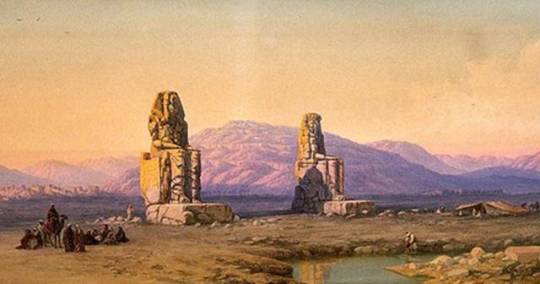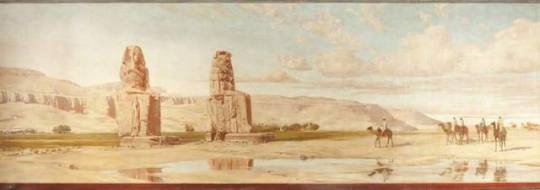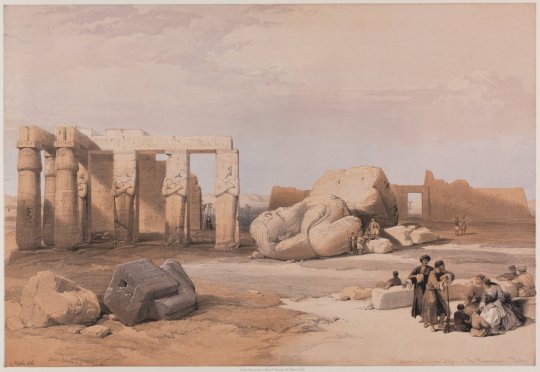#Memnonium
Text


PLATE II.
EGYPTIAN ART.
DECORATIVE PAINTINGS .
THE signification of the principal objects employed in Egyptian ornamentation is generally to be found in the language of hieroglyphics.
Thus, for instance, the pink sphere with hawk's wings (No. 6) represents the rising sun. The water-flowers mingled with reeds in the lower part of the plate (Nos. 4, 5) are types of running water. The scarabreus (No. 12), the black colour of which renders it so prominent, symbolizes immortality. The flowing ornaments (Nos. 10, 11) from which the Greeks afterwards made Vitruvian scrolls, signifying the rolling of the waves of the sea, had also a certain meaning in the language of Egyptian artists. Red, blue, and yellow were the principal colours employed, with black and white to define the outlines; green was used more particularly as a local colour, for stalks and parts of flowers, but in the more ancient paintings blue was frequently substituted for it.
Nos. 1, 2, 3.-Painted bouquets.
Nos. 4, 5.-Grounds, borders, and bases from Thebes.
No. 6.-Painted sculpture, from the Memnonium at Thebes. No. '7.-Undulating friezes.
Nos. 8, 9.-Painted sculptures.-Little wooden columns.
Nos. 10, 11.-Undulating_friezes.
No. 12.-Ceilings.
Taken from the publication of the French Commission on Egypt and Egyptian Art, by M. Prisse d' A vesnes
#Albert Racinet#1800s#1800s art#antiquity#ancient history#ancient egypt#egyptian#design#egyptian art#cultural art#art#illustration
4 notes
·
View notes
Photo

Templo funerario de Seti I, coñecido como Gran Templo de Abidos o Memnonium
17 notes
·
View notes
Photo

• Memnonium - the South Portico, Thebes (Osiride Columns, the Ramesseum, Thebes).
Date: 17 Mar 1862
Artist: Francis Bedford (1815-94)
Medium: Albumen print, mounted on card.
#19th century#19th century photo#19th century picture#picture#photo#photograph#photography#antique#antique picture#antique photo#memnonium#thebes#archeology#ramesseum#albumen print#francis bedford#1862
187 notes
·
View notes
Photo

Osiride pillars and Great Fallen Colossus, the Memnonium Thebes
Francis Frith
NYPL
27 notes
·
View notes
Photo

Gournah (Thèbes), Palais Dit le Memnonium, Félix Teynard, 1851–52, printed 1853–54, Metropolitan Museum of Art: Photography
Purchase, Lila Acheson Wallace Gift, 1976
Size: 24.5 x 30.1 cm. (9 5/8 x 11 7/8 in.)
Medium: Salted paper print from paper negative
https://www.metmuseum.org/art/collection/search/261841
14 notes
·
View notes
Photo

The Memnonium, Thebes. (Headless statues of Ramses II line the courtyard at the entrance to the Ramesseum, Luxor).
24 notes
·
View notes
Photo

“Fragments of the Great Colossi at the Memnonium”
Tinted lithograph, based on watercolours by David Roberts, from Louis Haghe’s Egypt and Nubia (1847)
2 notes
·
View notes
Text
Thoth
#72 (p.50)
Thoth is thus the God of writing and all the arts and sciences . On a monument of Seti I. he is called “ Scribe of the nine Gods . " He writes " the truth of the nine Gods , " and is called “ Scribe of the King of Gods and men . ”
Hence he is naturally inventor of the hieroglyphics , and patron and protector of all temple - archives and libraries , and of all scribes . At the entrance of one of the halls of the Memnonium at Thebes , the famous “ Library of Osymandias , ” called “ The great House of Life , " we find Thoth as “ Lord in the Hall of Books . " 1
Source: Hermes, T., Mead, G. R. S. (George Robert Stow). (1906). Thrice-greatest Hermes; studies in Hellenistic theosophy and gnosis. London and Benares: The Theosophical publishing society.
https://catalog.hathitrust.org/Record/001381148/Cite
0 notes
Photo

Gournah (Thèbes), Palais Dit le Memnonium by Félix Teynard, The Met's Photography Department
Medium: Salted paper print from paper negative
Purchase, Lila Acheson Wallace Gift, 1976 Metropolitan Museum of Art, New York, NY
http://www.metmuseum.org/art/collection/search/261841
4 notes
·
View notes
Photo










Man's Impact on the Environment
The Colossi of Memnon
Thebes, Theban Necropolis, Luxor, Egypt
The Colossi of Memnon (Arabic: el-Colossat or es-Salamat) are two massive stone statues of the Pharaoh Amenhotep III, who reigned in Egypt during the Dynasty XVIII. For the past 3,400 years (since 1350 BC), they have stood in the Theban Necropolis, located west of the River Nile from the modern city of Luxor.
The modern Arabic name is Kom el-Hatan, but it is generally known by the Roman name as the Temple of Memnon. Memnon was a hero of the Trojan War, a King of Ethiopia who led his armies from Africa into Asia Minor to help defend the beleaguered city but was ultimately slain by Achilles. Memnon (whose name means the Steadfast or Resolute) was said to be the son of Eos, the goddess of dawn. He was associated with colossi built several centuries earlier, because of the reported cry at dawn of the northern statue (see below), which became known as the Colossus of Memnon. Eventually, the entire Theban Necropolis became generally referred to as the Memnonium making him "Ruler of the west" as in the case of the god Osiris who was called chief of the west.
in the 19th century, William de Wiveleslie Abney noted that "the Arabs called these statues 'Shama' and 'Tama', and when speaking of them together gave them the appellation of Sanamât, or the idols."
0 notes
Photo

Abydos, Egypt – Memnonium of Seti I wall Inscriptions
39 notes
·
View notes
Text
Dahabiya Nile Cruises
Taking a fancy Nile Cruise down the Nile River is one of the best ways to discover the great amount of ruins that have survived along the years between Luxor and Aswan. Live the adventure on board Dahabiya Nile Cruises. Dahabiya is a small wooden ship that is distinguished by its amazing style and has the ability to sail to less accessible places. You will get to choose to start sailing from Luxor to Aswan and vice versa and find out the stunning amount of ruins and preservation located in some of the world’s most famous cities.
Get amazed visiting the astonishing temples Colossi of Memnon with our Luxury Merit Dahabiya Nile Cruise. Get to know more about Colossi of Memnon, Memnon was a hero of the Trojan War, a King of Ethiopia who led his armies from Africa into Asia Minor to help defend the beleaguered city but was ultimately slain by Achilles. Memnon was said to be the son of Eos, the goddess of dawn. He was associated with colossi built several centuries earlier, because of the reported cry at dawn of the northern statue , which became known as the Colossus of Memnon. Eventually, the entire Theban Necropolis became generally referred to as the Memnonium making him "Ruler of the west" as in the case of the god Osiris who was called chief of the west.
Fill your Soul with history, culture and knowledge while sailing from Luxor where you will visit some of the world’s most valuable treasures. Unleash your inner with Princess Donia Dahabiya and start your tours in Luxor visiting Valley of the Kings,Karnak Temple,Temple of Horus in Edfu and more.
On board Sonesta Amirat Dahabiya Nile Cruise you will discover a combination of luxury and privacy, updated with modern amenities for your comfort. Experience the fancy hospitality and sail the River in a classic way as the Dahabiya was used by the kings and elite who want to sail the Nile River .In Aswan you will get captivated by the nature beauty of the city while visiting its magnificent sightseeing such as the High Dam which was built to protect Egypt from the Nile flooding and considered an engineering miracle when it was built in 1952. Finally you will visit Philae Temple which is considered the main attraction in the city which built to honour the goddess Isis.

One of our Dahabiya Nile Cruises
Amoura Dahabiya Nile Cruise
Overview:
Sail on board Amoura Dahabiya Nile Cruise and enjoy extraordinary vacation, There's nothing like Amoura Dahabiya Nile cruise to ease your tensions, just relax on board your Dahabiya Cruise while sailing from Esna to Aswan or vice versa, visit Aswantemples and luxor sites, be ready to pack up and sail away from crowded and bustle.
Itinerary:
Aswan / Esna
04 Days / 03 Nights
Friday: The High Dam / Philae Temple
Plan Egypt Tours delegate will pick you up from Aswan Airport or Aswan Train station, beguile your eyes by visiting the High Dam built in 1960 to protect Egypt from the floods which was happened annually, then scout Philae temple, know more about Philae Temple as your guide will reveal the Story of this Amazing Temple, Finally at the end of your tour Plan Egypt Tours guide will escort you to Amoura Dahabiya Nile Cruise, check in, Lunch served on board, Sail to Kom Ombo, dinner and overnight on board Amoura Dahabiya Nile Cruise in Kom Ombo.
Saturday: Kom Ombo Temple
Once you wake up, get your breakfast on board, Scout Kom Ombo Temple, it has two entrance which makes it different than other temples, one entrance dedicated to "Sobek " with his crocodile head, and the second entrance dedicated to "Haroeris" with his falcon head, Kom Ombo Temple was built on the honor of two Gods, Sobek god and Haroeris, then sail to Gebel el Silsila Temple, Lunch served on board, arrive to the Speos of Hormoheb, Dinner will be served on the ground beside Hormoheb temple, or on the upper deck of your Dahabiya with fantastic music will match the mood, overnight on board Amoura Dahabiya Nile Cruise
Sunday: Edfu Temple / Sail to Esna
Once you wake up, get your breakfast on board, sail to Edfu, Explore Horus Temple in Edfu by Horse Carriage, then walk towards amazing Bazaar, Lunch served on board, next sail to an Island, dinner outside your Dahabiya depending on the weather status, or dinner will be on board at the sun deck of your Dahabiya, be ready tonight for the Fun including Arabic Music, Gallabeyah Party and belly dance, Sail to Esna, Overnight in Esna.
Monday: Valley of the Kings / Hatshepsut Temple / Colossi of Memnon / Karnak Temple
Once you wake up, get your breakfast on board, Disembarkation from Amoura Dahabiya Nile Cruise, then your guide will escort you to Luxor, Explore Valley of the Kings which astonished all travelers, (Visit will be to Three tombs), Proceed to visit Hatshepsut Temple known as well with the name of "El Deir El Bahari", focus on seeing the Colossi of Memnon, Next Excursion to Karnak Temple, then transfer to Luxor airport, or Luxor train station for final departure.
Esna / Aswan
05 Days / 04 Nights
Monday: Valley of the Kings / Hatshepsut Temple / Colossi of Memnon / Karnak Temple
Plan Egypt Tours delegate will pick you up from Luxor Airport or Luxor Train station, start your Awesome Excursion by visiting Valley of the Kings which astonished all travelers, (Visit will be to Three tombs), Proceed to visit Hatshepsut Temple known as well with the name of "El Deir El Bahari", focus on seeing the Colossi of Memnon, then Proceed to visit Karnak Temple, finally at the end of your tour your guide will escort you to Esna, check into your Dahabiya, Lunch served on board, Dinner and overnight on board Amoura Dahabiya Nile Cruise.
Tuesday: Edfu Temple
Once you wake up, get your breakfast on board, Sail to Edfu, scout the Temple of Hours in Edfu, then walk towards amazing Bazaar, then sail to Gebel el Silsila Temple, Lunch served on board, arrive to the Speos of Hormoheb, Dinner will be served on the ground beside Hormoheb temple, or on the upper deck of your Dahabiya with fantastic music will match the mood, overnight on board Amoura Dahabiya Nile Cruise
Wednesday: Kom Ombo Temple / Sail to Aswan
Once you wake up, get your breakfast on board, Sail to Kom Ombo, Scout Kom Ombo Temple, it has two entrance which makes it different than other temples, one entrance dedicated to "Sobek " with his crocodile head, and the second entrance dedicated to "Haroeris" with his falcon head, Kom Ombo Temple was built on the honor of two Gods, Sobek god and Haroeris, Next sail to Aswan, Lunch served on board, watch Donkeys on the banks of the Nile River going to their day to day business, watch different kinds of birds along the Nile river while you are sailing, Dinner and overnight on board Amoura Dahabiya Nile Cruise.
Thursday : The High Dam / Philae Temple
Once you wake up, get your breakfast on board, beguile your eyes by visiting the High Dam built in 1960 to protect Egypt from the floods which was happened annually, then scout Philae temple, know more about Philae Temple as your guide will reveal the Story of this Amazing Temple, Lunch served on board, then walk through amazing Bazaar in Aswan, Dinner and overnight on board Amoura Dahabiya Nile Cruise.
Friday: Amoura Dahbiay Nile Cruise / Final departure
Once you wake up, get your breakfast on board, Disembarkation from Amoura Dahabiya Nile Cruise, then transfer to Aswan airport, or Aswan train station for final departure.
Included:
· Meet & assist upon arrival at Airport or train station in Luxor or Aswan and transfer to your Dahabiya Nile Cruise
· Accommodation on board Amoura Dahabiya Nile Cruise including breakfast, lunch, dinner
· Sightseeing tours as mentioned at the above itinerary
· English speaking guide on board Amoura Dahabiya Nile Cruise
· Entrance fees to the above mentioned sites
· All Service Charges and taxes
· Assist and transfer to Airport or Train Station in Luxor or Aswan upon departure.
Excluded:
· Any Optional Tours
· Tip
For more info kindly visit: www.planegypttours.com
E-mail: [email protected]
Rana Hesham
0 notes
Photo

Gournah (Thèbes), Palais Dit le Memnonium, Félix Teynard, 1851–52, printed 1853–54, Metropolitan Museum of Art: Photography
Purchase, Lila Acheson Wallace Gift, 1976
Size: 24.5 x 30.1 cm. (9 5/8 x 11 7/8 in.)
Medium: Salted paper print from paper negative
https://www.metmuseum.org/art/collection/search/261841
14 notes
·
View notes
Photo

Egypt and Nubia, Volume II: Fragments of the Great Colossi at the Memnonium, Thebes, Louis Haghe, 1847, Cleveland Museum of Art: Prints
By the mid 19th century, the complexities of printing in numerous colors had been mastered, culminating in one of the high points of European printmaking. The plates drawn by Haghe, which copy the watercolors that David Roberts made in Egypt, are exquisite examples of color lithography. Egypt was a distant, mysterious country for Europeans and Haghe, a Scottish topographical and architectural artist who spent the year of 1838 traveling across this ancient land. The resulting prints—the first comprehensive series of views of the monuments, landscapes, and people of the Near East—were especially appreciated for their brilliant color and large scale. Bonebrake’s 134 prints of Egypt are an important addition to the Cleveland Museum of Art’s collection, and in a sense they have returned home: a large group of them was loaned to the 1992 exhibition Nineteenth-Century Views of Egypt.
Size: Sheet: 43.4 x 60.4 cm (17 1/16 x 23 3/4 in.); Image: 34.8 x 51 cm (13 11/16 x 20 1/16 in.)
Medium: color lithograph
https://clevelandart.org/art/2012.149
3 notes
·
View notes